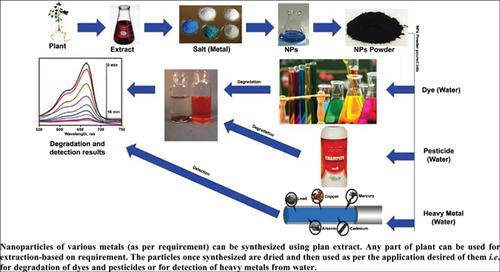Current Analytical Chemistry ( IF 1.7 ) Pub Date : 2021-05-01 , DOI: 10.2174/1573411016666200319100707 Sidra Amin 1 , Amber R. Solangi 2 , Dilawar Hassan 1 , Nadir Hussain 2 , Jamil Ahmed 2 , Hadi Bakhsh 2

|
Background: In recent years, the occurrence and fate of environmental pollutants has been recognized as one of the emerging issues in environmental chemistry. A survey documented a wide variety of these pollutants, which are often detected in our environment and these are a major cause of shortened life spans and global warming. These pollutants include toxic metal, pesticides, fertilizers, drugs, and dyes released into the soil and major water bodies. The presence of these contaminants causes major disturbance in the balance of the eco-system. To tackle these issues, many technological improvements are made to detect minute contaminations. The latest issue being answered by scientists is the use of green nanomaterials as sensors which are economical, instant and give much better results at low concentrations and can be used for the field measurements resulting in no dangerous by-product that could lead to more environmental contamination. Nanomaterials are known for their wide bandgap, enhanced physical, and optical properties with the option of tuneability as per need, by optimizing certain parameters. They are proved to be a good choice for analytical/ optical sensors with high sensitivity.
Objective: This review holds information about multiple methods that use green nanomaterials for the analytical assessment of environmental pollutants. UV-Vis spectrophotometry and electrochemical analysis using green and reproducible nanomaterials are the major focus of this review article. To date, there are a number of spectrophotometric and electrochemical methods available that have been used for the detection of environmental pollutants such as toxic metals, pesticides, and dyes.
Conclusion: The use of nanomaterials can drastically change the detection limits due to having a large surface area, strong catalytic properties, and tunable possibility. With the use of nanomaterials, lower than the marked limit of detection and limit of quantification were seen when compared with previously reported work. The used nanomaterials could be washed, dried, and reused, which makes the methods more proficient, cost-effective, and environmentally friendly.
中文翻译:

基于纳米材料的环境修复绿色分析方法的最新发展趋势
背景:近年来,环境污染物的发生和归宿已被认为是环境化学中新出现的问题之一。一项调查记录了这些污染物的种类繁多,这些污染物通常在我们的环境中被发现,并且这些是导致寿命缩短和全球变暖的主要原因。这些污染物包括释放到土壤和主要水体中的有毒金属,农药,肥料,药物和染料。这些污染物的存在会严重破坏生态系统的平衡。为了解决这些问题,进行了许多技术改进以检测微小的污染。科学家正在回答的最新问题是使用绿色纳米材料作为经济的传感器,瞬间,在低浓度下可获得更好的结果,可用于现场测量,不会产生可能导致更多环境污染的危险副产物。纳米材料以其带隙宽,增强的物理和光学特性以及通过优化某些参数根据需要进行可调整性的选择而闻名。事实证明,它们是高灵敏度分析/光学传感器的理想选择。
目的:本综述包含有关使用绿色纳米材料对环境污染物进行分析评估的多种方法的信息。使用绿色和可复制的纳米材料进行紫外可见分光光度法和电化学分析是本文的重点。迄今为止,已有许多分光光度法和电化学方法可用于检测环境污染物,例如有毒金属,农药和染料。
结论:纳米材料的使用具有较大的表面积,强大的催化性能和可调的可能性,因此可以大大改变检测限。与先前报道的工作相比,使用纳米材料时,发现其检出限和定量限均低于标记的限度。所用的纳米材料可以洗涤,干燥和再利用,这使得该方法更加有效,经济高效且环境友好。











































 京公网安备 11010802027423号
京公网安备 11010802027423号